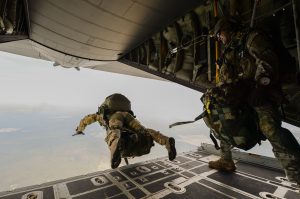This year will mark two decades since the beginning of the United States’ frequently rebranded but persistent global counterterrorism campaign. Most Americans might miss the anniversary, because the war is not one fought by a fully mobilized society — instead, the fighting has to a large degree fallen to a portion of the U.S. military, which itself represents only a small portion of the U.S. population.
Special Forces operations — of both the direct action, kill-or-capture variety and the lower-profile train-and-assist variety — were a central part of the War on Terror from its inception two decades ago under the George W. Bush administration. But they became a particular favorite of the Obama administration, since they held out the prospect of disrupting or defeating terrorist groups overseas without big, expensive and protracted engagements like Iraq or Afghanistan. The methodology of using elite forces, high-tech surveillance, and airstrikes to destroy non-state armed groups carried over to the Trump administration, which touted its reluctance to start new wars even as it carried out ever-more lethal special operations with less and less transparency in the existing ones. And that machinery has now passed through intact to a fourth administration, one headed by a man with a long record of proposing “light footprint” operations as an alternative to personnel-intensive counterinsurgency.
But even as those forces and missions have come to dominate the public image of U.S. warfighting, the world has changed. Ending the “forever war” has become a rallying cry among progressive foreign policy voices in the United States — and has at least some traction with the new president as well. And there is a largely bipartisan (though by no means universal) contention that the fundamental strategic challenge the U.S. is facing now stems more from powerful state competitors: China in the first instance, Russia to a lesser extent, and including sharp challenges from resurgent regional powers like North Korea. The inertia behind existing deployments should not be underestimated, as demonstrated by the torturous process of concluding the Afghan war. But the political backing for unlimited counterterrorism does seem to be fading.
And if the adversary of the U.S. military imagination is shifting from an irregular force to an advanced, heavily industrialized state, the mission and composition of special operations forces will have to shift with it. The presence of a modern integrated air defense network, for example, makes it much more complicated for special operators to launch aggressive raids supported by gunships and drones. Instead, they might spend more time on stealthy reconnaissance and quiet sabotage and less on direct action even as rare but high visibility missions like hostage rescue and high-value target raids remain firmly in their domain.
This shift is likely to be impacted by changes in technology, as well. While it is a category error to conflate the “drone war” with the entirety of the post-9/11 counterterrorism campaign, drones have done an increasing share of the killing involved, and a huge portion of the surveillance and communications tasks as well. There are certainly missions that drones cannot accomplish because of tactical or physical limitations, but as drones become more sophisticated and their weapons become more precise that envelope is narrowing.
This, in turn, might change the skill set that separates special forces troops from their counterparts. Discretion and restraint become far more important: Whereas there is little risk of further escalation if lethal force ends up being used on, say, the Islamic State a mission targeting a nuclear-armed adversary such as China or North Korea carries a far heavier potential penalty if things go wrong.
Training foreign militaries has always been a core special forces mission, from Lawrence of Arabia to the OSS to the Green Berets, though in the modern era much of that training has been geared toward Foreign Internal Defense — which is to say, combat against irregular forces rather than mechanized armies. That balance is likely to change, if it has not already: some of the key skills relevant in a battle against a nominally weaker guerrilla force are irrelevant in a battle against a conventional military (and vice versa).
In the longer term, though, the combination of strategic shift and advancing technology might change what “special forces” means. A unit using specialized drones for reconnaissance or sabotage tasks might not match our cultural expectation of an elite commando force, but in terms of capability and mission it might well deserve the distinction. And assuming autonomous technology advances — not only the software but the hardware to make long-duration missions with limited contact a real possibility — the risks of using human operators against technologically sophisticated rivals might come to increasingly outweigh the benefits. In such an eventuality, special forces might serve more in a forward control mode rather than as agents in their own right — which raises the usual questions about autonomy and meaningful command authority.
That possibility — of violence carried out for the state at an ever-increasing distance from mechanisms of public debate and accountability — brings us back to the beginning, to the increasingly distant relationship between public and policy, between policy and warfighter, and ultimately between warfighter and war. That cannot be rebalanced at the tip of the spear. Instead, it needs the public to re-engage in a serious way with questions of when, how, and against whom such forces should be used.

































